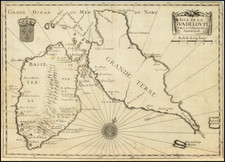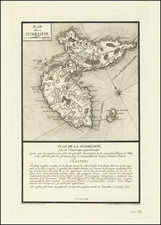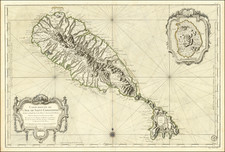Surveyed by Staff Commander J. Parsons, R.N., and assisted by Staff Commanders J.P. Dillon and W.B. Calver, R.N., in 1863, this chart of St. Vincent in the West Indies offers a detailed depiction of the island. The chart was published in London on November 24th, 1876, under the Superintendence of Captain E.J. Evans, R.N, and engraved by Davies & Company.
The historical significance of this maritime chart lies in its representation of the intricate geography of St. Vincent, a key island in the Lesser Antilles. Surveyed during a period of expanding naval power and increased interest in accurate cartography, the chart displays various coastal features, including springs, coral reefs, mud, rock, sand, shells, and stones. The utilization of data from a government survey of 1773 for the Northern portion of the Island, from Chateau Belair to Rabaca, provides a glimpse into the island's topographical history and the continuity of geographical knowledge.
The chart's annotations further delineate soundings in fathoms, heights in feet above high water springs, and critical nautical details. The note that there was "No Magnetic Variation in 1882" emphasizes the importance of magnetic data for navigational accuracy, reflecting the scientific advancements and precision that characterized naval surveying in the latter half of the 19th century. The careful and systematic approach of the British Admiralty in compiling and publishing this chart underscores Britain's leadership in maritime exploration and navigation during this era.
In addition to its navigational utility, the chart's aesthetic appeal, evident in the detailed coastal profile at the bottom, enriches its historical value.
As a document, this chart of St. Vincent not only serves as an essential tool for understanding the maritime practices and cartographic techniques of the time but also stands as a testament to the broader history of exploration, colonization, and naval power during the 19th century.









![[ Curacao / Aruba / Bonaire / Venezuela ] Pas-kaart vande zee custen van Venecuela met dye Bylegende Eylanden . . .](https://storage.googleapis.com/raremaps/img/small/99928.jpg)


![[St. Kitts] View of the Town and Harbour of Basse Terre in the Island of St. Christopher](https://storage.googleapis.com/raremaps/img/small/86560.jpg)

![[ Barbadoes ] Novissima et Acuratissima Barbados. Descriptio per Johannem Ogiluium. Cosmographum Regium](https://storage.googleapis.com/raremaps/img/small/86773.jpg)